Abstract
Beckwith-Wiedemann syndrome (BWS) was first described in the mid-1960s. It was originally called EMG syndrome based on the presence of exomphalos, macroglossia, and gigantism in many cases. There are now more than 500 cases reported in the literature and numerous cases diagnosed prenatally. With an incidence of 1:10,000, it is the most common of the overgrowth syndromes. The genetic mechanisms underlying BWS are complex and numerous but are known to involve perturbations of the balance of genes located at chromosome 11p15.5. As a result, the phenotype and clinical manifestations of BWS are variable. This chapter will review the pathophysiology of BWS, its clinical presentation, prenatal diagnosis with a focus on imaging techniques and their differential diagnosis, and management strategies.
Keywords
Beckwith-Wiedemann syndrome, prenatal diagnosis, overgrowth syndrome, macroglossia, imprinting
Introduction
Beckwith-Wiedemann syndrome (BWS) was first described in 1963 and 1964 by Beckwith, an American pediatric pathologist, and Wiedemann, a German geneticist. Since the first descriptions, more than 500 cases have been reported. Prenatal diagnosis of BWS was first reported in 1980. With the increased knowledge of the clinical features and possible causes of BWS, the diagnosis is now often suspected prenatally, allowing for genetic testing, counseling, and preparation for adequate neonatal care of affected infants. Close to 40 cases of BWS diagnosed prenatally have now been reported.
Disorder
Definition
BWS is a congenital somatic overgrowth disorder characterized by a constellation of abnormalities or physical findings that may include macrosomia, macroglossia, visceromegaly, and omphalocele or other umbilical cord anomalies. It was originally called EMG syndrome based on the presence of exomphalos, macroglossia, and gigantism in many cases.
Prevalence and Epidemiology
The exact prevalence of BWS is unclear and thought to be underestimated because of the variability of presentations and modes of inheritance of the syndrome, sometimes resulting in milder cases. Prevalence rates of 1 : 10,000 to 7 : 10,000 births have been reported in the general population, and as high as 2.5 : 10,000 in pregnancies conceived by in vitro fertilization (IVF). BWS has been described in various ethnic groups and has a male-to-female ratio of 1 : 1.
Etiology, Pathophysiology, and Embryology
The genetic mechanisms underlying BWS are complex but are known to involve perturbations of the balance of genes located at chromosome 11p15.5. Most cases of BWS are sporadic (85%). In 10% to 15% of cases, the mode of inheritance is autosomal dominant with incomplete penetrance and preferential maternal transmission. Less than 1% of affected individuals have a chromosomal abnormality such as a translocation, duplication, or inversion of chromosome 11p15. The genes for BWS at 11p15 are a highly imprinted region of the genome. Genomic imprinting is an epigenetic process by which genes from only one parental allele are expressed. In the case of band 11p15 of chromosome 11, the paternal allele is normally expressed, and the maternal allele is inactivated. Abnormal transcription and regulation of the genes may occur by various mechanisms, including the following :
- •
loss of methylation on maternal chromosome at IC2 (50%–60%)
- •
paternal uniparental disomy for chromosome 11p15 (10%–20%)
- •
gain of methylation on the maternal chromosome at IC1 (5%)
- •
deoxyribonucleic acid mutations of an imprinted gene (5%–10% of sporadic cases, 40% of autosomal dominant families)
- •
deletion or duplication of regions of the chromosome with imprinting genes (1%–2%)
Anomalies of the imprinting process are thought to occur during the preimplantation phase of embryonic development, in the early part of meiosis I and II. Assisted reproductive technologies (ARTs) have been linked to imprinting disorders including BWS. In most of these cases, isolated hypomethylation at the maternal KVDMR1 / LIT1 locus at 11p15.5 is demonstrated, in contrast to BWS cases not conceived by IVF in which this molecular mechanism is less common. This suggests that infertility and/or ARTs disturb methylation in the oocyte or early embryo.
Molecular genetic testing is available for 70% of the known mechanisms for BWS, including karyotyping and fluorescence in situ hybridization, uniparental disomy studies, methylation studies, and mutation scanning. Testing may be done prenatally or postnatally on the affected individual. Although the diagnosis of BWS is mostly clinical, genetic studies are important because they allow for genetic counseling of the family and determination of the risk to siblings and offspring of a person with BWS. Shuman et al. provide an in-depth discussion of genetic counseling in affected families. BWS has been reported numerous times in monozygotic twins, mostly female pairs discordant for the condition.
Manifestations of Disease
Clinical Presentation
Although there are no specific diagnostic criteria, BWS is characterized by various clinical features. Some authors suggested that the presence of a combination of one to three major features and one to three minor features be required to make the diagnosis of BWS. However, there does not seem to be agreement on what features should be considered major or minor. Clinical features of BWS and their frequency are listed in Table 109.1 , and divided into categories as follows:
- 1.
Clinical features include prenatal and postnatal macrosomia-gigantism (estimated fetal weight and/or abdominal circumference >90th percentile and height and weight >97th percentile), macroglossia (hyperplasia of muscle fibers, normal histology ), visceromegaly (liver, kidneys, adrenal glands, pancreas, and spleen), ear pits or creases, facial dysmorphology (midfacial hypoplasia, mandibular hypoplasia), and hemihyperplasia (abnormality of cell proliferation resulting in asymmetric overgrowth). Overgrowth is usually present at birth in affected individuals and worsens over time. The increase in size continues through early childhood and decreases with increasing age, so that adults with BWS are of normal size.
- 2.
Histopathology includes diffuse adrenal cytomegaly, pancreatic beta islet cell hyperplasia, and nephroblastomatosis and placental mesenchymal dysplasia.
- 3.
Structural fetal anomalies include omphalocele or other umbilical abnormalities (60%), renal anomalies (medullary dysplasia, cystic changes, diverticula, and nephromegaly), and rarely cardiac anomalies and cleft palate. Agenesis of the cerebellar vermis has been reported.
- 4.
Neonatal metabolic issues are hypoglycemia and hyperinsulinism that occasionally persists for a few months, nephrocalcinosis and hypercalciuria, polycythemia, and less commonly, hypothyroidism.
- 5.
Neoplasia is increased (5%–10%). Children with BWS are at increased risk for embryonal tumors, particularly Wilms tumor and hepatoblastoma but also neuroblastoma, adrenocortical carcinoma, and rhabdomyosarcoma. Tumors rarely develop after 10 years of age. Of tumors, 40% are associated with hemihypertrophy.
- 6.
Normal intellectual and social development occurs unless there is an underlying chromosomal anomaly or untreated severe hypoglycemia.
- 7.
Perinatal mortality of 10% to 20% is related to prematurity (30%–50%) and fetal anomalies.
| Clinical Features | Frequency (%) |
|---|---|
| Macrosomia | 88 |
| Macroglossia | 82–99 |
| Abdominal wall defects | 50–60 |
| Visceromegaly (≥1 intraabdominal organs) | 59 |
| Hemihyperplasia | 24 |
| Renal anomalies (nephromegaly, structural anomalies, nephrocalcinosis) | 62 |
| Hypoglycemia/hyperinsulinism | 50–75 |
| Facial nevus flammeus | 62 |
| Embryonal tumors in childhood | 4–10 |
| Polyhydramnios | 50–60 |
Imaging Technique and Findings
Ultrasound.
Since the first case of prenatal diagnosis of BWS was reported in 1980, about 40 cases have been reported. In most of them, macrosomia in the second or third trimester, macroglossia, enlarged kidneys, and polyhydramnios are the suggestive findings. When omphalocele is present (50%–80% of cases), the diagnosis can be suspected at 12 weeks’ gestation. However, less than 3% of omphaloceles are caused by BWS (5%–20% if isolated and of normal karyotype). Macroglossia in children is defined as protrusion of a resting tongue beyond the teeth or alveolar ridge. The diagnosis of macroglossia prenatally is subjective, although nomograms of the tongue size in the first and second trimester have been published.
The fetal tongue can be seen on ultrasound (US) in an inferior coronal view of the fetal face and in the sagittal profile view ( Figs. 109.1 and 109.2 ). A persistently protruding tongue in the absence of a discrete mass is consistent with macroglossia ( Fig. 109.3 ). Placentomegaly with cysts within the placenta is a common feature ( Fig. 109.4 ). Normal placental thickness in millimeters is usually equal to the number of weeks ± 10 mm. Large multicystic maternal ovaries may also be seen in association with elevated human chorionic gonadotropin levels.
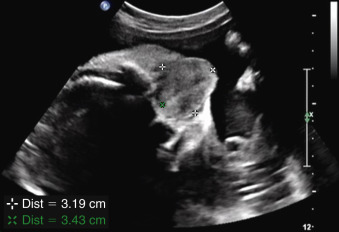
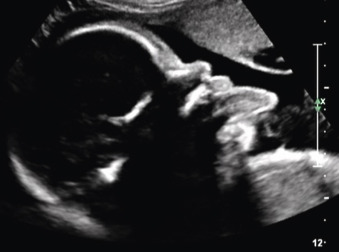
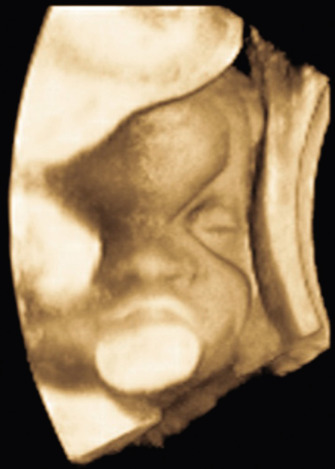
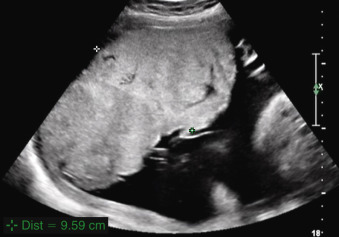
Fetal kidney enlargement (renal length >90th percentile) is present in 65% of cases with increased echogenicity of the kidneys ( Fig. 109.5 ). Renal anomalies are seen in 50% of these cases. The fetal kidneys are considered echogenic if the reflectivity of the parenchyma is greater than that of the liver. Polyhydramnios is found in 50% to 60% of cases, likely as a result of impaired fetal swallowing by the enlarged tongue. Prenatal diagnosis of intraabdominal tumors is limited to a few case reports including a pancreatoblastoma and bilateral adrenal carcinoma. One case of intracardiac rhabdomyoma has been reported.
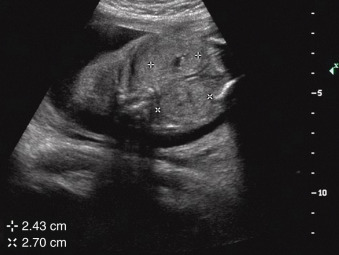
Magnetic Resonance Imaging.
Magnetic resonance imaging may be useful to characterize renal, adrenal, or pancreatic tumors if they are suspected.
Other Applicable Modality.
Increased nuchal translucency with omphalocele ( Fig. 109.6 ) was reported in one fetus with BWS. Alpha-fetoprotein may be elevated in BWS with or without omphalocele.
Macrosomia
Macroglossia
Visceromegaly (kidneys in particular)
Polyhydramnios
Enlarged cystic placenta
Omphalocele
Stay updated, free articles. Join our Telegram channel

Full access? Get Clinical Tree






